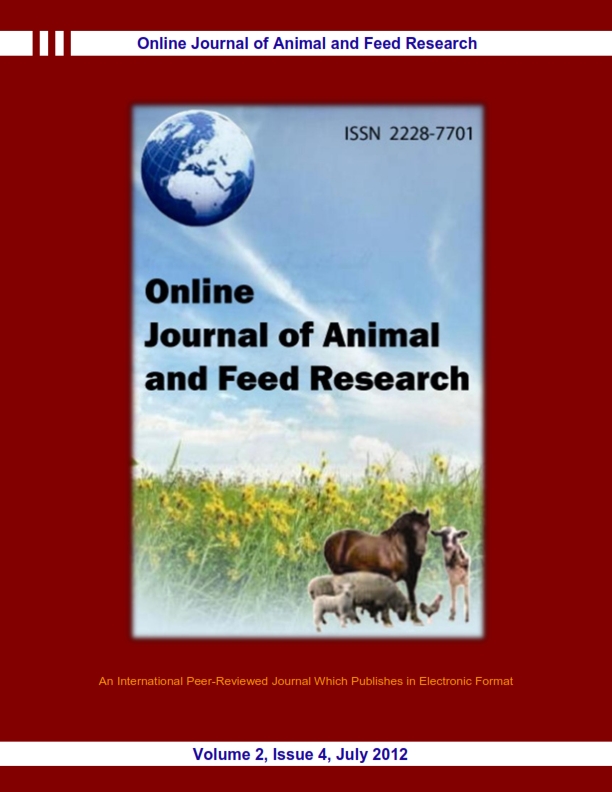|
Research Title/ Field
|
Article (Abstract)
|
Download
|
|
Growth rate and carcass characteristics of large white pigs fed on ensiled cassava pulp diets
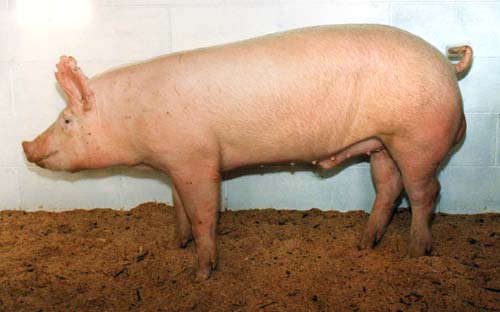
|
Original Research, B61
Rhule, SWA, Asiedu P, Baiden RY, Ameleke GY, Sottie, ET and Otsyina HR.
Online J. Anim. Feed Res., 2(4): 328-331, 2012.
ABSTRACT: Twenty four Large White (LW) grower pigs at an average live weight of 27 kg were distributed over three treatments made up of diets containing 0, 25 and 30 percent ensiled cassava pulp. Diets were made similar to contain 15% Crude protein. Pigs were taken off the study on attaining an individual live weight of 60±5 kg slaughtered and carcass characteristics determined. The average live weight gains by the pigs were 0.40, 0.42 and 0.44 kg/day on Diet 1 (0%), Diet 2 (25%) and Diet 3 (30%) respectively. The feed conversion ratios by the pigs were 4.20, 4.30 and 5.00 kg feed /kg live-weight gain for Diets 1, 2 and 3 respectively. Eye muscle area of the pigs were 33.2, 27.3 and 37.7cm2 on Diets 1, 2 and 3 respectively. Trimmed fat on the carcasses were 3.3, 2.6 and 2.4 kg respectively. The study indicated that cassava pulp could be preserved by ensiling for feeding pigs over the grower phase at least: That the cassava pulp fed at an inclusion rate of 30% gave pig performance comparable to that on the cereal-based diet. It was indicated that maize, could be completely replaced in the diet of the grower pig with ensiled cassava pulp.
Key words: Average Daily Gain, Crude Protein, Ensiled Cassava Pulp, Feed Conversion Ratio Grower Pigs, Live Weight
|
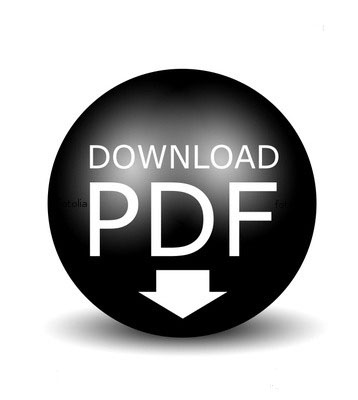
|
|
Effect of supplementation of concentrate to sweet sorghum (Sorghum bicolor L. Moench) bagasse leaf residue silage on performance and carcass characteristics in native sheep


|
Original Research, B62
Vidya, B., Ramana Reddy, Y. and Srinivasa Rao, D.
Online J. Anim. Feed Res., 2(4): 332-339, 2012.
ABSTRACT: The effect of supplementation of concentrate at different levels to sweet sorghum leaf residue (SSBLR) silage on the performance, and carcass characteristics was studied using Nellore growing ram lambs in a 120 day growth trial. A randomized design was applied with groups of seven growing ram lambs (14.05±0.61) and age (4 months), blocked by weight, allocated to one of four treatments; SSBLR silage ad lib (R-1), SSBLR silage + concentrate 170 g (R-2), SSBLR silage + concentrate 225 g (R-3) and SSBLR silage + concentrate 280 g (R-4). At the end of growth trial five representative lambs from each group were slaughtered to study the carcass characteristics and meat quality. The CP NDF and ADF content of SSBLR silage was 7.48, 71.81 and 46.75 per cent, respectively. The average daily gain (ADG) of ram lambs fed ration R-4 were significantly (P<0.01) higher than those fed R-1 and R-2 ration, but the value was comparable with the R-3 ration. The total DMI (g/d) was significantly (P<0.01) higher in lambs fed R-2, R-3 and R-4 rations compared to R-1 ration but DMI (g/d or % b.wt.) from SSBLR silage was not influenced by the level of concentrate supplementation. Negative FCR was recorded in lambs fed sole SSBLR silage and FCR was improved with supplementation of concentrate from R-2 to R-4 rations. Significant difference (P<0.05) in FCR was observed between lambs fed R-2 and R-3, R-4 rations but there was no significant difference between the lambs fed R-3 and R-4 rations. The lambs fed sole SSB silage lost their body weight of 2.14 kg during experimental period resulting in negative ADG and negative FCR. Supplementation of concentrate at 280 g to SSBLR silage resulted in significantly lower cost/kg gain than the other rations. Carcass weight and dressing percentage was linearly (P<0.01) increased as the proportion of concentrate increased in the diet. Supplementation of concentrate at different levels did not significantly influence the per cent whole sale cuts, yield of visceral organs and proportion of meat, bone and fat in whole carcass and chemical composition of meat. The results of the present study indicated that supplementation with energy and protein rich feeds to SSBLR was necessary and concentrate supplementation at 280 g to SSBLR silage found to be optimum for better growth rate, feed efficiency and meat quality in growing Nellore ram lambs.
Key words: Sweet sorghum bagasse leaf residue silage, Supplementation, Performance, Carcass characteristics, Sheep
|

|
|
Pre-weaning growth performance of Sekota sheep breed in Waghimra zone, Ethiopia
|
Original Research, B63
Yiheyis A, Tegegn F, H/Melekot M, Taye M.
Online J. Anim. Feed Res., 2(4): 340-343, 2012.
ABSTRACT: Pre-weaning growth performances of Sekota sheep breed was studied at Sekota district of Amhara National Regional State, Ethiopia under traditional crop-livestock production systems which is characterized by extensive, low-input low-output system. Two hundred thirty one lambs were monitored from birth to weaning age. Data on growth performances were collected and analyzed using the general linear model procedures of Statistical analysis system software. The least squares mean birth weight, three months weight and average daily weight gains from birth to three months age were 2.73 kg, 11.9 kg and 101 gm, respectively. Parity and type of birth were significant sources of variation for birth weight. Location had an effect of three months weight. The results obtained revealed the potential of the breed for meat production in the prevailing environment. The effect of parity on birth weight indicates special care for lambs from maiden ewes. Management options like integrated health care and supplementation of feed for sheep during the dry season help farmers to benefit from their sheep.
Key words: Growth Performance, Pre-Weaning, Sekota Sheep, Daily Weight Gain
|

|
|
Productivity of desert sheep under grazing condition in north Kordofan, Sudan

|
Original Research, B64
Dawelbait E.M., Gadallah G.B., Bushara I.
Online J. Anim. Feed Res., 2(4): 344-347, 2012.
ABSTRACT: This study was conducted in North Kordofan State, with the objectives of studying performance of desert sheep (Hamari) on natural grazing during the dry season, and to investigate the nutritional value for the rangelands prevailing in the region. To achieve the objectives chemical analysis was done for some plants and trees to determine the nutrients and mineral content according to (AOAC, 1990). In vitro dry matter digestibility and organic matter digestibility were also determined according to Tilley and Terry (1963). Animal digestibility trial was successfully done, when ten rams were reared on natural rangelands for three consecutive grazing periods (30, 60 and days) to study the performance. The data was analyzed as completely randomized block design via analysis of variance with the assistance of SPSS and statitix8 software. The results of chemical analysis showed that CP, CF, ash, EE and NFS were in the range from 6-10, 35-45, 7-10, 1.1-2.1 and 36.7-46.7% respectively. The chemical analysis for selected browse trees were CP5.1%, CF 31-33%, EE 0.4-0.9%, ash 7-8.1% and NFE 53-56.9%. Mineral contents ranged from 0.0144-0.075 ppm for P, 0.002-0.063 ppm for K and 1-2.9 ppm for Iodine. In vitro DM and OM digestibility ranged from 52-59 and 52-62%, respectively. Rams grazing on natural rangelands recorded weight gains during the first grazing period (December), and then they lost weight at the second period (January) and recorded a high weight loss during the third period (February, January-July). Based on the findings it can be concluded that rangelands in the region were deteriorating in quality and quantity as a result which negatively affects livestock performance due to negative effect on animal weight gain leading to weight loss during the period January-July. There is a high need for introducing supplementary feeding and mineral additives.
Key words: North Kordofan, animal performance, In vitro, Digestibility, Rangelands
|

|
|
Some hematological values for captive Gazella dorcas

|
Original Research, B65
Mohammed Ahmed FA, Mohammed Salih RR, Yousif RA
Online J. Anim. Feed Res., 2(4): 348-350, 2012.
ABSTRACT: Normal mean values for Hemoglobin, packed cell volume, red blood cell count, white blood cell count, erythrocyte sedimentation rate, were obtained from blood of six males and nine females Gazelle Dorcas. Males had significantly higher values for white blood cell count, and had significantly lower values for red blood cell count than the females. The rest of the parameters were not significantly different between the two sexes. With the exception of the correlation between red blood cell and the packed cell volume, were insignificant.
Key words: Hematology, Values, Count, Blood, Gazella dorcas
|

|
|
Communal livestock production in Simbe, Gokwe south district of Zimbabwe


|
Original Research, B66
Maburutse, B.E., Mutibvu, T., Mbiriri, D.T., Kashangura, M.T.
Online J. Anim. Feed Res., 2(4): 351-360, 2012.
ABSTRACT: Communal livestock production systems are dynamic being responsive to changes in the socio-political and economic environments. A survey was conducted in Simbe communal area of Gokwe South District in Zimbabwe, to assess current livestock production systems. Five villages and 3 wards were randomly selected and a semi-structured questionnaire administered by 5 trained enumerators to collect data on; house-hold demographics, livestock species kept and their numbers, uses of livestock and waste, feeding and watering as well as livestock health management. Data were analysed using the Statistical Package for the Social Sciences (SPSS) version 16. It was observed that farmers in the study area kept a wide range of livestock species including; poultry (notably; chickens, ducks, turkeys and guinea fowls), goats, cattle, donkeys and pigs. Cattle and goats were the major sources of draught power and income, respectively. Farmers indicated that they faced challenges in feeding and watering their animals during the dry season. Diseases were the major cause of offspring mortality in most animal species while predation was the major cause in chickens. It was recommended that farmers acquire education on production and improve on health and general management.
Key words: Livestock, Draught Power, Dry Season, Cattle, Manure, Natural Veld
|

|
|
Haematological indices of captive black neck ostriches
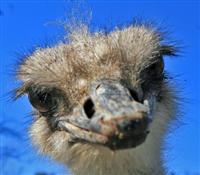
|
Original Research, B67
Mohamed Ahmed F.A., Yousif R.A., EL Hessan, Mohmmed Salih RR
Online J. Anim. Feed Res., 2(4): 361-364, 2012.
ABSTRACT: This study was conducted at Sudan University of Science and Technology College of Veterinary Medicine and Animal Production Department of fisheries science and wildlife in June 2011 to determine hematological values of Black Neck Ostrich Struthio Camelus massaicus collected from El Safa farm North Khartoum. Values of some hematological parameters of 14 Black Neck Ostrich 7 male and 7 female age from 3-4 year, and 70–75 kg in weight were examined to determine the mean values obtained for White Blood cells Count (WBC), Erythrocytes Count (RBC), Hemoglobin Concentration Rates (Hb), Packed Cell Volume (PCV), Mean Corpuscular Volume (MCV/cl) and Erythrocytes Sedimentation Rate (ESR). The result of this study show that there are no significant different in all blood values between samples collected from male and female at p (P<0.05), expect in Red Blood Cells (RBC) there is significant different at (P<0.05). The main target of this study is to comparison between hematological values of Black Neck Ostrich in both male and female.
Key words: Hematological, Ostrich, Parameters, Captivity, Birds
|

|
|
Haematological Characteristics of C.garipienius collected from White Nile and Blue Nile at Khartoum State


|
Original Research, B68
Mohammed Ahmed F.A., Yousif R.A., Ahmed Hamed S.H., Mohammed Salih R.R., Abaas Bakheet H.H.
Online J. Anim. Feed Res., 2(4): 365-368, 2012.
ABSTRACT: This study was conducted at Sudan University of Science and Technology Collage of Animal Production Science and Technology Department of fisheries science and wildlife to determine haematological characteristics of Clarias garipienius collected from White Nile and Blue Nile River. Values of some haematological parameters of twenty C. gariepinus were in the range 41- 49 cm in length and 709 – 806 gm in weight were analyzed to determine the mean values obtained for White Blood cells Count (WBC) and Erythrocytes Count (RBC), Hemoglobin Concentration Rates (Hb), Packed Cell Volume (PCV) and Mean Corpuscular Volume (MCV/cl) and Leukocytes Differential Counts and chemical analysis of total protein and Blood Glucose. The result of this study show that there are no significant different in all parameters between samples collected from White Nile and Blue Nile at (p<0.05), expect in hemoglobin concentration there is highly significant different at (p<0.01). The main target of this study is to investigate the hematological parameters and some blood chemistry of Clarias garpieninus collected from White Nile River and Blue Nile River in Khartoum State.
Key words: Haematologocal parameters, Nile fishes, C.garpinus
|

|
|
Isolation and characterization of a lipolytic and phytase producing probiotic for potential application in poultry feed
 

|
Original Research, B69
Razdan K., Parihar J., Bajaj B.K
Online J. Anim. Feed Res., 2(4): 000-000, 2012.
ABSTRACT: In the current study a total of 35 bacterial isolates from 17 food and fecal samples were examined. Five among those were earmarked as putative probiotic candidates. All the selected isolates survived the low pH conditions of 2.0, and resisted the presence of bile salts (0.02-0.25%) and NaCl (2-14 %), indicating their ability to survive in the gastrointestinal (GI) tract conditions and hence making them suitable candidates for probiotic applications. The selected probiotic isolates showed considerable levels of hydrophobicity indicating their potential adhering properties with the gut epithelium. In addition the five selected probiotic candidates depicted substantial antagonistic action against potent pathogens like Bacillus subtilis, B. cereus, Escherichia coli, Pseudomonas aeruginosa, P. alcaligenes, Staphylococcus aureus and Streptococcus sp. The isolates CM-4 and KD-7 were most remarkable as they inhibited all the pathogens tested including S. aureus and Streptococcus sp. Extracellular enzymatic studies showed that all the five strains produced phytase whereas isolate CM-4 and KD-7 were the only lipase producers found. However no amylase protease activity was detected. Isolate CM-4 was found to be the best among all five as it showed all desirable probiotic features viz. bile salt, NaCl and pH tolerance, maximum hydrophobicity, antagonistic action against pathogens, phytase and lipase activity, therefore was identified by using 16S rDNA sequencing and MEGA BLAST.
Key words: Probiotics, Phytase, Lipases, Hydrophobicity, Antibacterial Activity
|

|
|
The requirements of crude protein by large white breeding sows and piglets in Ghana

|
Original Research, B70
Rhule S.W.A., Asiedu P.
Online J. Anim. Feed Res., 2(4): 378-383, 2012.
ABSTRACT: Eighteen Large White gilts at an average initial live weight of 100.39kg were distributed by completely randomized block design over three treatments. There were three cereals-based diets with three different calculated levels of crude protein (CP) namely control breeder diet, Diet 1 (13.16% CP), Diet 2 (12.56% CP) and Diet 3 (12.01% CP) with corresponding lactation diets namely control lactation Diet 1 (LD1) (16.00% CP), Diet 2 (LD2) (14.50%CP) and Diet 3 (LD3) (13.20%CP). Additionally there were three creep diets comprising control Diet 1 (CD1) with 23.01%CP, Diet 2 (CD2) with 21.46% CP and Diet 3 (CD3) with 20.00% CP. The average live litter size of sows were 8.50, 8.40 and 6.67 on Diets 1, 2, and 3 respectively (P>0.05). The number of piglets weaned decreased with decreasing CP in the diet being 7.83. 7.80 and 5.33 on Diets 1, 2 and 3 respectively but were not found to be significantly (P>0.05) different. The average birth weights of the piglets were similar at 1.45, 1.34 and 1.40 kg on Diets 1, 2 and 3 respectively (P>0.05). The milk yield by the sows at 28 days of lactation were found to be 3.06, 3.03 and 5.44kg/day on LD1, 2 and 3 and significantly (P<0.05) different being higher on the lowest CP diet. There was inconsistency with the milk yield at 42 days of lactation with significantly (P<0.05) different values of 4.87, 8.33 and 3.60kg/day on lactation with lactation diet 1, 2, and 3 respectively. It was observed that live weight gains by the sows during gestation significantly (P<0.05) increased with decreasing CP levels in the diets and were 30.3, 36.3 and 34.0 kg on Diets 1, 2 and 3 respectively. The ADGs of the piglets on the creep diets were 0.22, 0.17 and 0.19 kg/day on CD1, CD2 and CD3 respectively, and found to be significantly (P<0.05) different. The study indicated that decreasing levels of CP in the diet at gestation could affect the reproductive performance of the Sow. Decreasing CP in the lactation diet significantly affected sow performance adversely. Whereas a decrease of 1.5% CP in the lactation diet gave similar performance in the sow as the control 3.0% decrease in the CP markedly reduced the performance. Decreasing CP in the creep diets significantly reduced the ADG of the piglets. It was shown that 1.5% reduction in the CP in the creep diets significantly decreased the average daily gain of the piglets compared to that on the control.
Key words: Average Daily Gain, Birth Weight, Dietary Protein Requirement, Large White Gilts, Milk Yield, Weaning Weight.
|

|
|
A study on the prevalence of sheep and goat skin defects in Bahir Dar Tannery, Ethiopia
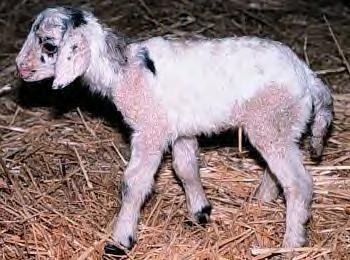
|
Original Research, B71
Assefa M., Tesfaye D., Taye M.
Online J. Anim. Feed Res., 2(4): 384-387, 2012.
ABSTRACT: A study to estimate the prevalence of sheep and goats skin defect was carried out at Bahir Dar Tannery. A total of 400 (200 sheep and 200 goat) sheep and goat skins were sampled and examined for skin defect at pickled stage. The study showed that there were different skin defects responsible for the decline in quality grades of skin. From the total skin examined, ekek (58.3%), scratch (22.5%), flying defect (13.8) and scar (11.3%) were common defects. For sheep skins ekek (67%), processing defect (12.5%), scratch (12%) and processing defect (8.5%) were important skin defects and only small number (8.5%) were with no defect. In goats skin, ekek (49.5%), scratch (33%), scar (17.5%) and flying defect (15%) were important defects. Skin quality grades 6 (22.3%), 5 (21.8%) and 4 (18.5%) were frequently observed skin grades. There were unappreciable numbers of rejects (12%) while quality grade 1 was the least frequent (6.3%). Ekek was significantly (p<0.05) higher in sheep skin (53%) than goat skin (23.5%). However; scratch was significantly (p<0.05) higher in goat than in sheep, but other defects were not significantly (p>0.05) different between the two species. Examination also showed that 26 (13.5%) and 22 (11%) were rejected in sheep and goat skins, respectively. Integrated efforts towards good animal husbandry and animal health care are very important for better quality skin. Furthermore, detailed studies on the distribution, seasonal occurrence and the direct and indirect economic impact of ectoparasites should be undertaken. Meanwhile, tanneries should collaborate with such studies to maximize the economic gain in the long run.
Key words: Ectoparasite, Ekek, Goat Skin, Sheep Skin, Skin Defect, Pickled Skin
|

|
|
Comparison of slaughter, carcass values of Sudan ecotypes goats fed different levels of energy/protein
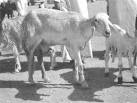
|
Original Research, B72
Tameem Eldar A.A., Elamin K.M., Amin A.E., Hassan H.E.
Online J. Anim. Feed Res., 2(4): 388-393, 2012.
ABSTRACT: This experiment aimed to assess the slaughter and carcass values of different Sudan goat ecotypes (Nubian, Desert and Swiss Nubian) fed different levels of energy/protein. Nine male goat kids (2-3 months and average weight 9.23 kg) of either ecotypes were used in a 3x3x3 arrangement, fed three experimental diets A (control), B and C, with varying energy: protein 1:0.14, 1:0.16 and 1:0.18 respectively. The study showed that Nubian goats possessed heavier slaughter weight; empty body weight, warm and cold carcass weight than the Desert and Swiss Nubian goats in the ration B and C. Dressing percentage on both basis (slaughter weight and empty body weight) of Nubian were higher for ration B and C. Warm carcass weights of all goat ecotypes increased directly with energy: protein ratio. Highest weight of leg, loin, rack and neck and shoulder were recorded by Nubian goats for ration B and C. It was concluded that, all ecotype kids respond well to increasing energy protein levels. According to the results obtained local goat ecotypes, mainly Nubian goats, responded well to improved nutrition, therefore results obtained can be applied for the local goat ecotypes studied to encourage goat meat consumption and exportation.
Key words: Leg, Loin, Nubian, Neck, Rack, Shoulder
|

|
|
Effect of Dietary Levels of Cowpea (Vigna unguiculata) Seeds on Egg Quality
 

|
Original Research, B73
Balaiel N.G., Abd Elati Kh.A., Dousa B.M.
Online J. Anim. Feed Res., 2(4): 394-397, 2012.
ABSTRACT: The objectives of this study were to evaluate the effect of including 3 dietary levels of grain meal cowpea (Vigna unguiculata) 0, 5, 10 and 15% on external and internal egg characteristics. Seventy two laying hen of 28 weeks age were randomly allocated into 4 dietary treatments of 0, 5, 10 and 15% levels of cowpea seeds, which were further replicated 6 times in completely randomized design. Feed and water supply were offered to birds ad libitum while standard management practices were adopted. The results showed that the external parameters like maximum length and width, shell thickness and shell % and egg weight were significantly (P<0.05) affected by dietary treatments. Egg shape index was not significantly (P>0.05) influenced by dietary treatments. Internal quality characteristics were not significantly (P>0.05) affected by dietary treatments except for albumin weight, albumin percentage, yolk index and yolk colour. It is concluded that commercial egg characteristics such as egg weight is satisfactory maintained with 5 to 1`0% inclusion of cowpea grain meal in balanced diets for layers.
Key words: Cowpea Levels, Layers, Eggs
|

|
|
Original Research, B70
------
Online J. Anim. Feed Res., 2(4): 000-000, 2012.
ABSTRACT:
Key words: |
|
|
|
|
|
|
|
|
|
|
|
|
|
|
|
|
|
|
|
